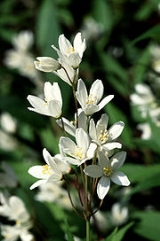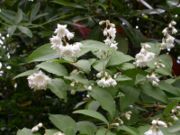
Deutzia
Encyclopedia
Deutzia is a genus
of about 60 species of shrub
s in the family Hydrangeaceae
, native to eastern and central Asia
(from the Himalaya east to Japan
and the Philippines
), and Central America
and also Europe. By far the highest species diversity is in China, where 50 species occur.
The species are shrubs ranging from 1–4 m in height. Most are deciduous
, but a few subtropical species are evergreen
. The leaves
are opposite, simple, with a serrated margin. The flower
s are produced in panicle
s or corymbs; they are white in most species, sometimes pink or reddish. The fruit
is a dry capsule
containing numerous small seed
s. Identification of the species is very difficult, requiring often microscopic detail of the leaf hairs and seed capsule structure.
Selected species
 The deutzias are fairly new to gardens: the exception, D. scabra, was noticed in Japanese gardens by Engelbert Kaempfer
The deutzias are fairly new to gardens: the exception, D. scabra, was noticed in Japanese gardens by Engelbert Kaempfer
(1712) and Carl Peter Thunberg
(1784) but not actually seen in Europe till the 1830s; two-thirds of the species noted in the R.H.S.
Dictionary were gathered in from the wild during the 20th century.
Deutzias are commonly grown as ornamental plant
s for their white flowers. Many cultivar
s and hybrids have been selected for garden use, including selections with double flowers. For example, Deutzia x lemoinei is a hybrid of D. gracilis and D. parviflora.
The temperate deutzias are mostly bone-hardy shrubs, from Far Eastern regions where winters are dependably frozen; in milder climates, like much of England, the early-flowering species and hybrids are coaxed into premature bloom by mild spells, then spoilt by frost. Alice Coats remarks that deutzias done better in Edinburgh, on the chilly east coast of Scotland than they do in London. A solution in milder climates might be to site deutzia in the garden's most exposed, coldest microclimate, as is often done with early-flowering magnolias.
Identification can be difficult, and in particular, many of the plants in cultivation sold as D. scabra are actually D. crenata (Huxley 1992). The selected hybrid white double "Pride-of-Rochester", already in cultivation in 1881, was originated y the Rochester, New York
nurserymen Ellwanger and Barry
.
Genus
In biology, a genus is a low-level taxonomic rank used in the biological classification of living and fossil organisms, which is an example of definition by genus and differentia...
of about 60 species of shrub
Shrub
A shrub or bush is distinguished from a tree by its multiple stems and shorter height, usually under 5–6 m tall. A large number of plants may become either shrubs or trees, depending on the growing conditions they experience...
s in the family Hydrangeaceae
Hydrangeaceae
Hydrangeaceae are a family of flowering plants in the order Cornales, with a wide distribution in Asia and North America, and locally in southeastern Europe.-Overview:...
, native to eastern and central Asia
Asia
Asia is the world's largest and most populous continent, located primarily in the eastern and northern hemispheres. It covers 8.7% of the Earth's total surface area and with approximately 3.879 billion people, it hosts 60% of the world's current human population...
(from the Himalaya east to Japan
Japan
Japan is an island nation in East Asia. Located in the Pacific Ocean, it lies to the east of the Sea of Japan, China, North Korea, South Korea and Russia, stretching from the Sea of Okhotsk in the north to the East China Sea and Taiwan in the south...
and the Philippines
Philippines
The Philippines , officially known as the Republic of the Philippines , is a country in Southeast Asia in the western Pacific Ocean. To its north across the Luzon Strait lies Taiwan. West across the South China Sea sits Vietnam...
), and Central America
Central America
Central America is the central geographic region of the Americas. It is the southernmost, isthmian portion of the North American continent, which connects with South America on the southeast. When considered part of the unified continental model, it is considered a subcontinent...
and also Europe. By far the highest species diversity is in China, where 50 species occur.
The species are shrubs ranging from 1–4 m in height. Most are deciduous
Deciduous
Deciduous means "falling off at maturity" or "tending to fall off", and is typically used in reference to trees or shrubs that lose their leaves seasonally, and to the shedding of other plant structures such as petals after flowering or fruit when ripe...
, but a few subtropical species are evergreen
Evergreen
In botany, an evergreen plant is a plant that has leaves in all seasons. This contrasts with deciduous plants, which completely lose their foliage during the winter or dry season.There are many different kinds of evergreen plants, both trees and shrubs...
. The leaves
Leaf
A leaf is an organ of a vascular plant, as defined in botanical terms, and in particular in plant morphology. Foliage is a mass noun that refers to leaves as a feature of plants....
are opposite, simple, with a serrated margin. The flower
Flower
A flower, sometimes known as a bloom or blossom, is the reproductive structure found in flowering plants . The biological function of a flower is to effect reproduction, usually by providing a mechanism for the union of sperm with eggs...
s are produced in panicle
Panicle
A panicle is a compound raceme, a loose, much-branched indeterminate inflorescence with pedicellate flowers attached along the secondary branches; in other words, a branched cluster of flowers in which the branches are racemes....
s or corymbs; they are white in most species, sometimes pink or reddish. The fruit
Fruit
In broad terms, a fruit is a structure of a plant that contains its seeds.The term has different meanings dependent on context. In non-technical usage, such as food preparation, fruit normally means the fleshy seed-associated structures of certain plants that are sweet and edible in the raw state,...
is a dry capsule
Capsule (fruit)
In botany a capsule is a type of simple, dry fruit produced by many species of flowering plants. A capsule is a structure composed of two or more carpels that in most cases is dehiscent, i.e. at maturity, it splits apart to release the seeds within. A few capsules are indehiscent, for example...
containing numerous small seed
Seed
A seed is a small embryonic plant enclosed in a covering called the seed coat, usually with some stored food. It is the product of the ripened ovule of gymnosperm and angiosperm plants which occurs after fertilization and some growth within the mother plant...
s. Identification of the species is very difficult, requiring often microscopic detail of the leaf hairs and seed capsule structure.
Selected species
|
Deutzia ningpoensis Deutzia ningpoensis is a shrub in the family Hydrangeaceae. The species is endemic to China. It grows to between 1 and 2.5 metres high and produces panicles of white flowers from May to July in its native range.... Deutzia silvestrii Deutzia silvestrii is a plant species in the family Hydrangeaceae.... |
Cultivation and uses

Engelbert Kaempfer
Engelbert Kaempfer , a German naturalist and physician is known for his tour of Russia, Persia, India, South-East Asia, and Japan between 1683 and 1693. He wrote two books about his travels...
(1712) and Carl Peter Thunberg
Carl Peter Thunberg
Carl Peter Thunberg aka Carl Pehr Thunberg aka Carl Per Thunberg was a Swedish naturalist and an apostle of Carl Linnaeus. He has been called "the father of South African botany" and the "Japanese Linnaeus"....
(1784) but not actually seen in Europe till the 1830s; two-thirds of the species noted in the R.H.S.
Royal Horticultural Society
The Royal Horticultural Society was founded in 1804 in London, England as the Horticultural Society of London, and gained its present name in a Royal Charter granted in 1861 by Prince Albert...
Dictionary were gathered in from the wild during the 20th century.
Deutzias are commonly grown as ornamental plant
Ornamental plant
Ornamental plants are plants that are grown for decorative purposes in gardens and landscape design projects, as house plants, for cut flowers and specimen display...
s for their white flowers. Many cultivar
Cultivar
A cultivar'Cultivar has two meanings as explained under Formal definition. When used in reference to a taxon, the word does not apply to an individual plant but to all those plants sharing the unique characteristics that define the cultivar. is a plant or group of plants selected for desirable...
s and hybrids have been selected for garden use, including selections with double flowers. For example, Deutzia x lemoinei is a hybrid of D. gracilis and D. parviflora.
The temperate deutzias are mostly bone-hardy shrubs, from Far Eastern regions where winters are dependably frozen; in milder climates, like much of England, the early-flowering species and hybrids are coaxed into premature bloom by mild spells, then spoilt by frost. Alice Coats remarks that deutzias done better in Edinburgh, on the chilly east coast of Scotland than they do in London. A solution in milder climates might be to site deutzia in the garden's most exposed, coldest microclimate, as is often done with early-flowering magnolias.
Identification can be difficult, and in particular, many of the plants in cultivation sold as D. scabra are actually D. crenata (Huxley 1992). The selected hybrid white double "Pride-of-Rochester", already in cultivation in 1881, was originated y the Rochester, New York
Rochester, New York
Rochester is a city in Monroe County, New York, south of Lake Ontario in the United States. Known as The World's Image Centre, it was also once known as The Flour City, and more recently as The Flower City...
nurserymen Ellwanger and Barry
George Ellwanger
George Ellwanger was a prominent horticulture scientist. Ellwanger was born in Württemberg, Germany and emigrated to the United States. Settling in Rochester, New York Ellwanger joined with Patrick Barry to form the Mount Hope Nursery in 1840. He also became an American citizen in 1840...
.

